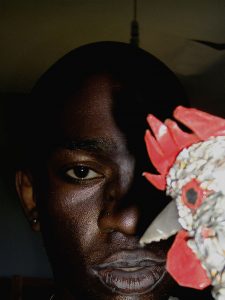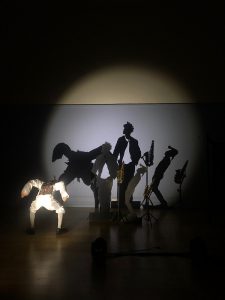“The club and church comparison has been spoken about for years but I guess I wanted to test out the limitations of the club space using the DJ format,” writes Curtly Thomas over email, on the way the artist, musician and DJ uses the term ‘ceremonial acts’ as one of numerous aliases. “Like what feelings can we produce here, will you receive it, what does it mean to be ‘free’ in here?”

We are emailing after last week’s release of AQNB’s Between two stars, music and art compendium, to which Thomas contributes two new visual works under the smallboydanger moniker. Working across performance, music and the outer limits of fashion and garment-making, Thomas also DJs as clubcouture, hosted a series of ‘participatory noise parties’ Wrack-It-Head at Ormside Projects, and collaborates with artists Adam Gallagher and Ruth Angel Edwards as Unwelcome Collection. A playful fluidity runs across these pseudonyms, where coherence seems intentionally skewed in favour of process, conversation and constant deconstructions of identity.
“The sets progressed to include a participatory role for the audience with whistles, perhaps an attempt to fabricate carnival spirit,” Thomas says on performances such as the Wrack-It-Head nights, referring also to collaborations with Gallagher. “I would usually aim to induce the spirit of an idol of mine and Adam’s, Miss Miles, a well-dressed political whistle-blower from Trinidad. The result would really be a cacophony of sound, some joyful harmonious imbalance.”
This generous love for freeform discussion—along with a will to unpick norms in the process—is evident as Thomas talks a range of topics from interdependence and solidarity to club spaces, costume to carnival traditions.
**There are really nice moments in a clubcouture Rinse FM show from last year where what sounds like a recorded conversation between you and Adam Gallagher is overlaid. It feels like the network of artists around you and your community plays a really strong role in your work, would you say so? How does art making serve as a bridge for having broader conversations and community-building?
Curtly Thomas: I love to share and exchange ideas like everybody does. I think more often than not people are trying to project that they are alone or have individual thoughts, because that’s how we’re taught to build a strong ‘brand’ or identity, both in art practices and privately.
For me art making has got to be fluid, I’m constantly making connections between people, or ideas or material; these can in turn expose a collective train of thought. Me and Adam have had a lot of fun over the years building ideas and manifesting via conversation, sculpture, performances. He once literally whitewashed mirrors, licked his finger and rubbed the names of the rich white men responsible for the fore-planned demolition of Elephant and Castle Shopping Centre, whilst I called out their names on a mic, bingo-style.

Our conversations have become a really important part of my process and especially throughout that period. When making sound, I often want to honour this openness by including a bunch of recordings. It’s the same with a lot of my previous work; breaking down the public and private is always something I find endearing.
**One thing that’s really appealing about the various projects you’ve been involved in—like for instance the Wrack-It-Head nights—is how it feels like getting a network of people together under one roof, a physical community, is crucial. Since our ability to gather together has been reduced this year, I’m wondering what the last few months have brought to mind for you about the importance of assembly?
CT: For a while, I really wanted to test the waters, like what new energy could we create bouncing around in the same space? I worked in the club where I threw all of those nights, so I could tweak things like the set, lights or where the DJs performed, and where the live acts would go. We had costume and make-up bars during one night—I miss those nights! Using the club as a space to recreate the world on our terms was really important then.
Right now, we are all pretty aware of how interdependent we all are. I’ve always recognised this connection/dependency; whether via the cosmos or via capitalism, we are some sort of unbalanced web and now it feels like solidarity can be performed differently.
Over the past months after George Floyd and the multiple state murders of black and indigenous people both in America and worldwide, black people have been grouping together to support each other on and offline, moving from a place of compassion which has been really beautiful to see. Me and artist Nkisi recently launched a project Axis Arkestra in which we raise funds for black charitable organisations. Eventually, we want to create a foundation that can aid black people by issuing loans and grants.
**Clothing and garments play a role in your performance practice. Can you tell us about your relationship with garments, clothing or costume?
CT: I have worked as a stylist/art director, in casting and sometimes assisting on massive TV ads on-and-off for the last five-to-six years. I learnt a lot about characterisation, visual storytelling and how the creative industry reinforces stereotypes; it can be so vulgar but I definitely adopted some understanding from these worlds.
It took me a long time to realise I didn’t love fashion, just the characters fashion has the potential to produce. It is a sort of mimicry of our everyday drag—costume has the ability to freely explore yourself in plain sight. Trinidad and Tobago’s mega rich history of costume designers has had the biggest influence on me. Their ability to scale, and restyle, re-use common objects and play with symbolism is unparalleled! It’s sort of a protest art culture jam.
**Your works for the compendium are photographs that capture very fleeting moments from performances. With the absences of live events this year, how have your thoughts on documentation evolved?

CT: Ah, I’ve been creating performance work for about three-to-four years now but it still feels pretty new to me, or at least performing on my own does. I was picking up regular gigs and really building my relationship with this idea of taking your ‘show’ on the road before lockdown—a bit like a clown, big suitcase ‘n’ all.
The images are examples of some new photography work I’m creating at the moment. Repeatedly embodying characters in front of a camera has definitely altered my understanding of performance. I channel a sort of self-induced self awareness when shooting, as the slightest movement or light refraction warps/births new meaning in the photo. When performing for the camera the limitations are totally different; time sort of collapses and then opens up again.
In the beginning of lockdown, a friend of mine and incredible painter, Samuel Hindolo, introduced me to Octavia Butler, a black science fiction writer. She has this ‘shapeshifting’ character ‘Doro’ in her Patternist series. I won’t say too much but his manipulative ability to switch bodies is wild!
**In some of your performances you reference the carnival tradition of playing Mas. Could you tell us a bit about this and how it informs your work?
CT: Mostly my work in this period under ‘smallboydanger’ has been addressing ideas around masculinity as a performance, really framing it as make-believe; a perpetuated act. In recent performances I re-enact its (masculinity) limits on our potential, emotionally and spiritually, I look at it with blurry eyes as it is also something I am so connected to—‘daddy issues’ lol. I’m still this little kid constantly searching for idols. Like, “who is the blueprint!?”
For me Mas (carnival) is free of such limitations; its history suggests that our conservative european roleplay can be unlearned and that we are all playing these shifting characters in one big fete. The traditional characters are played by anyone who feels connected to the character’s appearance or history of characteristics (although these are constantly updated), meaning everyone’s in drag, like some unified cosplay—for me, this is the space to ignite change.**














